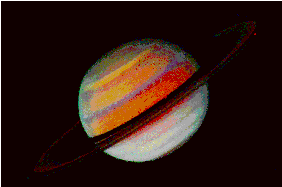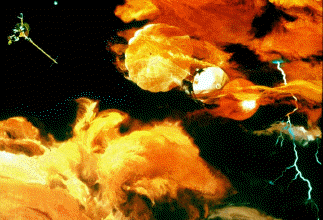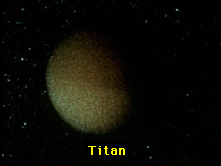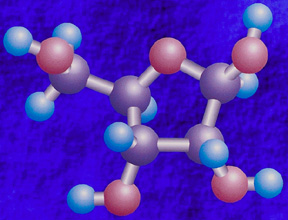This is an image of Saturn.
Click on image for full size
NASA/JPL
The Environment of Saturn
Saturn's atmospheric environment is one of strong gravity, high pressure, strong
winds, from 225 miles per hour to 1000 miles per hour, and cold temperatures of -270 degrees to +80 degrees. With winds like these, it is hard to have peace and quiet.
The region where it is 80 degrees sounds pretty friendly, but where the temperature is 80 degrees, the pressure is about the same as it would be if you were a couple miles below the sea on Earth!
In the atmosphere there are at least three known cloud decks of ammonia, ammonia hydrosulfide, and water, with perhaps sizable condensed droplets. Moreover there is energy from lightning, ultraviolet light, and charged particles.
Saturn's interior possesses an environment of pressures as great as three million times the sea-level pressure on earth, and temperatures as high as 10,000 degrees.
Overall, this environment sounds very unfriendly to life as we know it on earth.
You might also be interested in:

The striped cloud bands on Saturn, like Jupiter, are divided into belts and zones. In a belt, the wind flows very strongly in one direction only. In a zone, the wind flows very strongly in exactly the
...more
Jupiter's atmospheric environment is one of strong gravity, high pressure, strong winds, from 225 miles per hour to 1000 miles per hour, and cold temperatures of -270 degrees to +32 degrees (freezing temperature).
...more
In July, 1996, it was announced that Dr. David McKay, along with a team of scientists at Johnson Space Center (a division of NASA), had discovered possible fossils of bacteria in an ancient rock from Mars.
...more
Saturn's atmospheric environment is one of strong gravity, high pressure, strong winds, from 225 miles per hour to 1000 miles per hour, and cold temperatures of -270 degrees to +80 degrees. With winds
...more
Titan's atmosphere is a lot like the Earth's, except that it is very cold, from -330 degrees to -290 degrees! Like the Earth, there is a lot of Nitrogen and other complex molecules. There also may be an
...more
Autotrophs are organisms that produce organic compounds from an inorganic source of carbon (carbon dioxide) given a source of energy. If the source of energy is the reactions of inorganic chemical compounds,
...more
In the warm primordial ocean, aggregates of amino acids, proteins, and other hydrocarbons coalesced into a form called *coacervates*. Organic polymers such as amino acids will spontaneously form coacervates
...more














